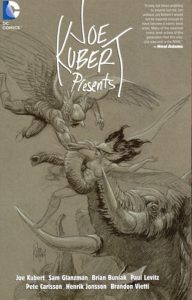Comic Book Review: Joe Kubert Presents by Joe Kubert and others
Joe Kubert (1926-2012) was one of the all-time great comic book artists. The bulk of his work was done for DC Comics, including many Hawkman and Sergeant Rock stories. Joe Kubert Presents was his final series, a tribute to him by the company he’d done so much for. Mr. Kubert was given free rein to choose which stories to do, and which other creators he wanted to share the spotlight with. Rather than risk an announcement of the series ahead of time only to not be able to deliver (this had happened to him before), Mr. Kubert insisted on having several issues “in the can” before it was put on order forms for retailers. The sixth issue was nearly complete when he died.
The first issue leads off with “Hawkman”; this iteration is closest to the science fiction-inspired Silver Age version, but not in continuity with any previous story. Katar Hol and his partner Shayera (Hawkgirl) are sent from the utopian planet Thanagar to observe Earth up close and determine what steps should be taken in the future. The Thanagarians worry that the Earthlings will not mature out of their destructive behavior before they develop interstellar travel.
The aliens land in Africa, observe the wanton slaughter of wildlife and environmental destruction, and decide to visit a nearby village. Unfortunately, this particular village sits atop a toxic waste dump; the poverty-stricken villagers have become economically dependent on the storage fees. The villagers worry that the Thanagarians have come to stop the practice and react badly.
While I understand the good intent of the story, it really does look like technologically advanced white people lecturing primitive native Africans on proper respect for the environment. And the Hawks destroy the natives’ livelihood and leave without considering that consequence, so their victory leaves a bitter aftertaste.
“Spit” is a recurring feature about an orphan who runs away from the orphanage and winds up stowing away on a whaling ship. In short vignettes, he suffers much abuse, but eventually learns how to survive at sea and decides to become a whaler. The first few chapters are in sepia tone, but the finale is mostly in full color. One (landlubber) character is implied to be a pedophile, but is thwarted before he can do anything.
“The Redeemer” is three chapters of a series Mr. Kubert solicited back in the 1980s before he discovered he wouldn’t be able to deliver it on time. Jim Torkan is the title character, a man who reincarnates across time and space to gain the wisdom he will need to eventually save the human race from itself. He is the target of the Infernal One, who sends agents to tempt Torkan from the path of righteousness, so that the Redeemer will be under his control.
The first two chapters take place in the far future, as Torkan is a scientist whose space station is invaded by murderous robbers seeking a chemical he’s developed that can control minds. His love interest is actually an agent of the Infernal One who tries to convince him to join up with the would-be dictator to save his own skin. The third chapter has Torkan as an ex-Confederate soldier just after the Civil War. The story carefully avoids mentioning what the Confederacy fought for beyond “justice and right” (hint: slavery), but it was all a waste and Torkan is without purpose. He gets involved in a treasure hunt, but at the end discovers something more precious than gold: himself.
“Farewell” was Kubert’s last Sergeant Rock story. The son and grandson of one of Easy Company’s soldiers visit a D-Day beach and the cemetery nearby. They discuss the possible death of Rock, but in the end it doesn’t matter if he is buried here–a piece of each soldier who fell rests with every other soldier.
“The Biker” is about a wounded Afghanistan veteran and motorcyclist who bunks down for the night in an abandoned house. But maybe not as abandoned as it looks. Some excellent coloring work here.
Then there are two stories written by Joe Kubert, but with art by other people. “The Ruby” (art by Henrik Jonsson) is about bandits attacking a Himalayan temple–it turns out to be a possible origin story for an obscure DC character. “Devil’s Play” (art by Brandon Vietti) is a Kamandi story, as the last boy on Earth battles the animal-men that have taken over the planet. This story offers a different explanation for the Great Disaster than usual.
The series also contained several “U.S.S. Stevens” stories by Sam Glanzman, telling tales of his WWII service aboard that destroyer. “The Figurehead” is the most interesting of these, featuring an eccentric crewmate of Mr. Glanzman’s who may or may not have had unusual abilities (it’s possible that this is a sailor’s yarn and he’s pulling our leg a bit.) This material has been collected separately, along with Mr. Glanzman’s other memoirs.
Brian Buniak gives us “Angel and the Ape”, based on the Bob Oksner series about private detectives Angel O’Day (an attractive human woman) and Sam Simeon (a cartoonist who also happens to be a gorilla.) It’s not quite in continuity with any other appearance of the characters, but as a comedy strip, continuity was never a huge issue. The pair are hired to prevent a restaurateur from being murdered; they do so but he is shot anyway, and they have to figure out whodunnit. After they solve that case, a reporter gets the story of their origin (or at least Angel’s version.) There’s an energy and attention to humorous background details reminiscent of early Mad, but sometimes the exaggerated art style can go a bit off.
If you are a fan of Joe Kubert’s art, this volume is a must-have; if you’re indifferent to that, the stories are only average, and the problematic material may knock this down a star or two for you. I liked this very much.

